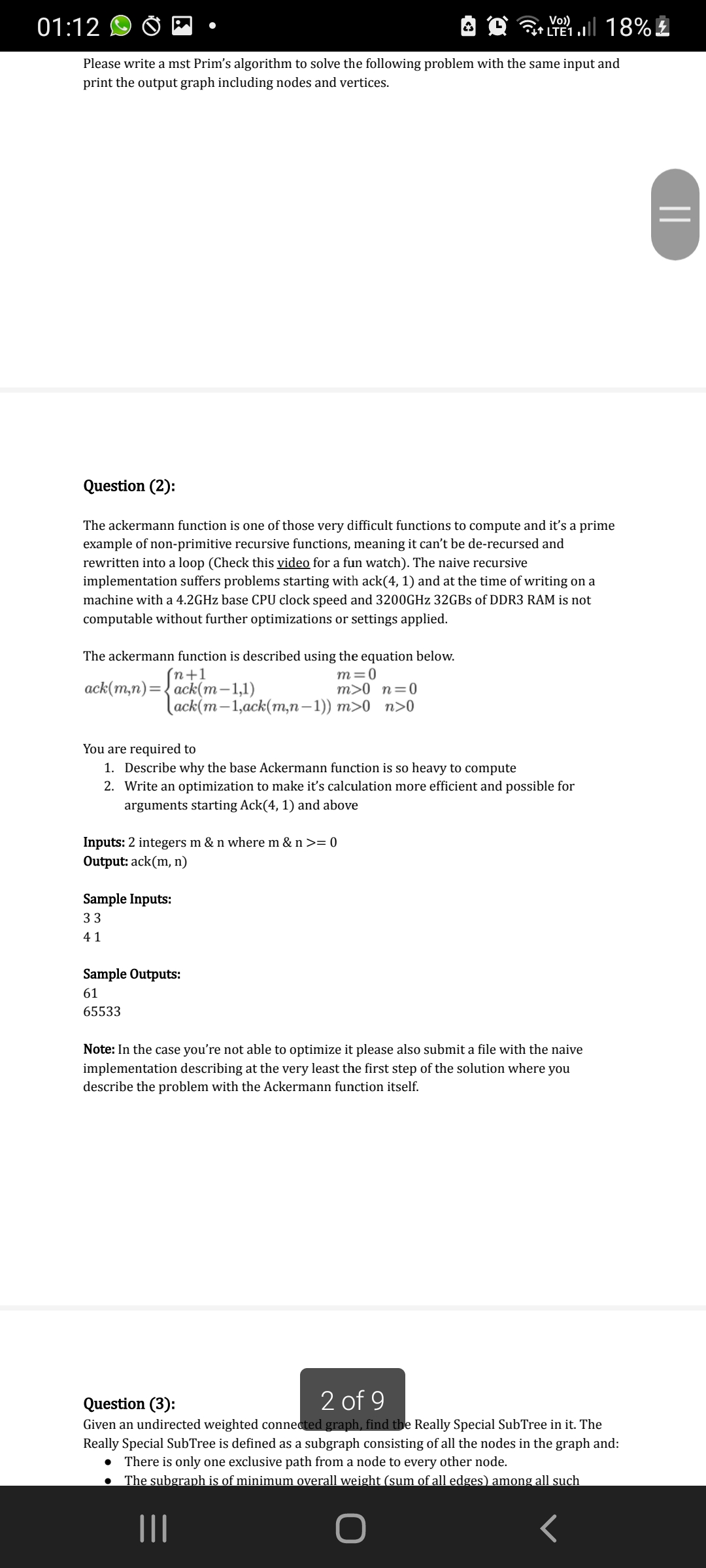Question (2): The ackermann function is one of those very difficult functions to compute and it's a prime example of non-primitive recursive functions, meaning it can't be de-recursed and rewritten into a loop (Check this video for a fun watch). The naive recursive implementation suffers problems starting with ack(4, 1) and at the time of writing on a machine with a 4.2GHZ base CPU clock speed and 3200GHZ 32GBS of DDR3 RAM is not computable without further optimizations or settings applied. The ackermann function is described using the equation below. (n+1 ack(m,n)={ ack(m-1,1) m=0 m>0 n=0 lack(m-1,ack(m,n–1)) m>0 n>0 You are required to 1. Describe why the base Ackermann function is so heavy to compute 2. Write an optimization to make it's calculation more efficient and possible for arguments starting Ack(4, 1) and above Inputs: 2 integers m & n where m & n >= 0 Output: ack(m, n) Sample Inputs: 33 41 Sample Outputs: 61 65533 Note: In the case you're not able to optimize it please also submit a file with the naive implementation describing at the very least the first step of the solution where you describe the problem with the Ackermann function itself.
Question (2): The ackermann function is one of those very difficult functions to compute and it's a prime example of non-primitive recursive functions, meaning it can't be de-recursed and rewritten into a loop (Check this video for a fun watch). The naive recursive implementation suffers problems starting with ack(4, 1) and at the time of writing on a machine with a 4.2GHZ base CPU clock speed and 3200GHZ 32GBS of DDR3 RAM is not computable without further optimizations or settings applied. The ackermann function is described using the equation below. (n+1 ack(m,n)={ ack(m-1,1) m=0 m>0 n=0 lack(m-1,ack(m,n–1)) m>0 n>0 You are required to 1. Describe why the base Ackermann function is so heavy to compute 2. Write an optimization to make it's calculation more efficient and possible for arguments starting Ack(4, 1) and above Inputs: 2 integers m & n where m & n >= 0 Output: ack(m, n) Sample Inputs: 33 41 Sample Outputs: 61 65533 Note: In the case you're not able to optimize it please also submit a file with the naive implementation describing at the very least the first step of the solution where you describe the problem with the Ackermann function itself.
Database System Concepts
7th Edition
ISBN:9780078022159
Author:Abraham Silberschatz Professor, Henry F. Korth, S. Sudarshan
Publisher:Abraham Silberschatz Professor, Henry F. Korth, S. Sudarshan
Chapter1: Introduction
Section: Chapter Questions
Problem 1PE
Related questions
Question

Transcribed Image Text:Vo)
01:12
LTE1.| 18% £
Please write a mst Prim's algorithm to solve the following problem with the same input and
print the output graph including nodes and vertices.
Question (2):
The ackermann function is one of those very difficult functions to compute and it's a prime
example of non-primitive recursive functions, meaning it can't be de-recursed and
rewritten into a loop (Check this video for a fun watch). The naive recursive
implementation suffers problems starting with ack(4, 1) and at the time of writing on a
machine with a 4.2GHZ base CPU clock speed and 3200GHZ 32GBS of DDR3 RAM is not
computable without further optimizations or settings applied.
The ackermann function is described using the equation below.
(n+1
ack(m,n) %3D ack(т-1,1)
m=0
m>0 n=0
(ack(m —1,аck(m,п — 1)) т>0 п>0
You are required to
1. Describe why the base Ackermann function is so heavy to compute
2. Write an optimization to make it's calculation more efficient and possible for
arguments starting Ack(4, 1) and above
Inputs: 2 integers m & n where m & n >= 0
Output: ack(m, n)
Sample Inputs:
33
41
Sample Outputs:
61
65533
Note: In the case you're not able to optimize it please also submit a file with the naive
implementation describing at the very least the first step of the solution where you
describe the problem with the Ackermann function itself.
2 of 9
Question (3):
Given an undirected weighted connected graph, find the Really Special SubTree in it. The
Really Special SubTree is defined as a subgraph consisting of all the nodes in the graph and:
• There is only one exclusive path from a node to every other node.
The subgraph is of minimum overall weight (sum of all edges) among all such
II
||
Expert Solution
This question has been solved!
Explore an expertly crafted, step-by-step solution for a thorough understanding of key concepts.
Step by step
Solved in 2 steps with 1 images

Knowledge Booster
Learn more about
Need a deep-dive on the concept behind this application? Look no further. Learn more about this topic, computer-science and related others by exploring similar questions and additional content below.Recommended textbooks for you

Database System Concepts
Computer Science
ISBN:
9780078022159
Author:
Abraham Silberschatz Professor, Henry F. Korth, S. Sudarshan
Publisher:
McGraw-Hill Education

Starting Out with Python (4th Edition)
Computer Science
ISBN:
9780134444321
Author:
Tony Gaddis
Publisher:
PEARSON

Digital Fundamentals (11th Edition)
Computer Science
ISBN:
9780132737968
Author:
Thomas L. Floyd
Publisher:
PEARSON

Database System Concepts
Computer Science
ISBN:
9780078022159
Author:
Abraham Silberschatz Professor, Henry F. Korth, S. Sudarshan
Publisher:
McGraw-Hill Education

Starting Out with Python (4th Edition)
Computer Science
ISBN:
9780134444321
Author:
Tony Gaddis
Publisher:
PEARSON

Digital Fundamentals (11th Edition)
Computer Science
ISBN:
9780132737968
Author:
Thomas L. Floyd
Publisher:
PEARSON

C How to Program (8th Edition)
Computer Science
ISBN:
9780133976892
Author:
Paul J. Deitel, Harvey Deitel
Publisher:
PEARSON

Database Systems: Design, Implementation, & Manag…
Computer Science
ISBN:
9781337627900
Author:
Carlos Coronel, Steven Morris
Publisher:
Cengage Learning

Programmable Logic Controllers
Computer Science
ISBN:
9780073373843
Author:
Frank D. Petruzella
Publisher:
McGraw-Hill Education